Abstract
The question addressed in this report focuses on the autoantigenicity of self antigens, principally cytochrome c and lysozyme. Of interest is whether the immune system produces autoantibodies to its host proteins reacting randomly with all potential antigen sites or is autoreactively selective for certain determinants. Based on experimental evidence from autoantibodies against cytochromes c, Jemmerson and Margoliash [Jemmerson, R. & Margoliash, E. (1979) Nature (London) 282, 468-471] have described a striking correlation between autoreactive sequence regions and evolutionary instability. While their analysis of evolutionary variation was based on simple sequence variability plots, we present here a refined approach that takes into account the distinction between evolutionary substitutions that induce a change in the protein surface from those that do not (surface-neutral substitutions). A quantitative aspect of surface variation (surface consensus) is included in the algorithm that produces a ranked order for autoantigenic determinants. The final plot, called surface variability, indicates sequence regions having a preference for autoimmune reaction. We propose the term "autogen" to designate such protein determinants.
Full text
PDF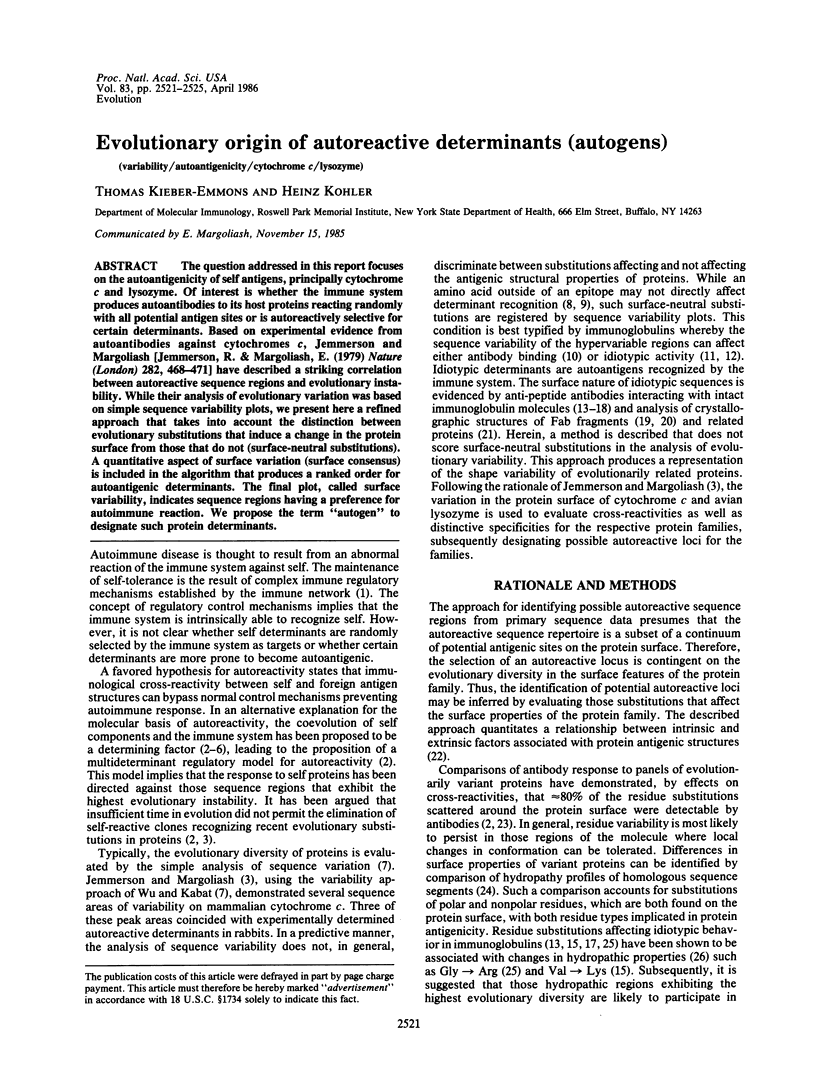
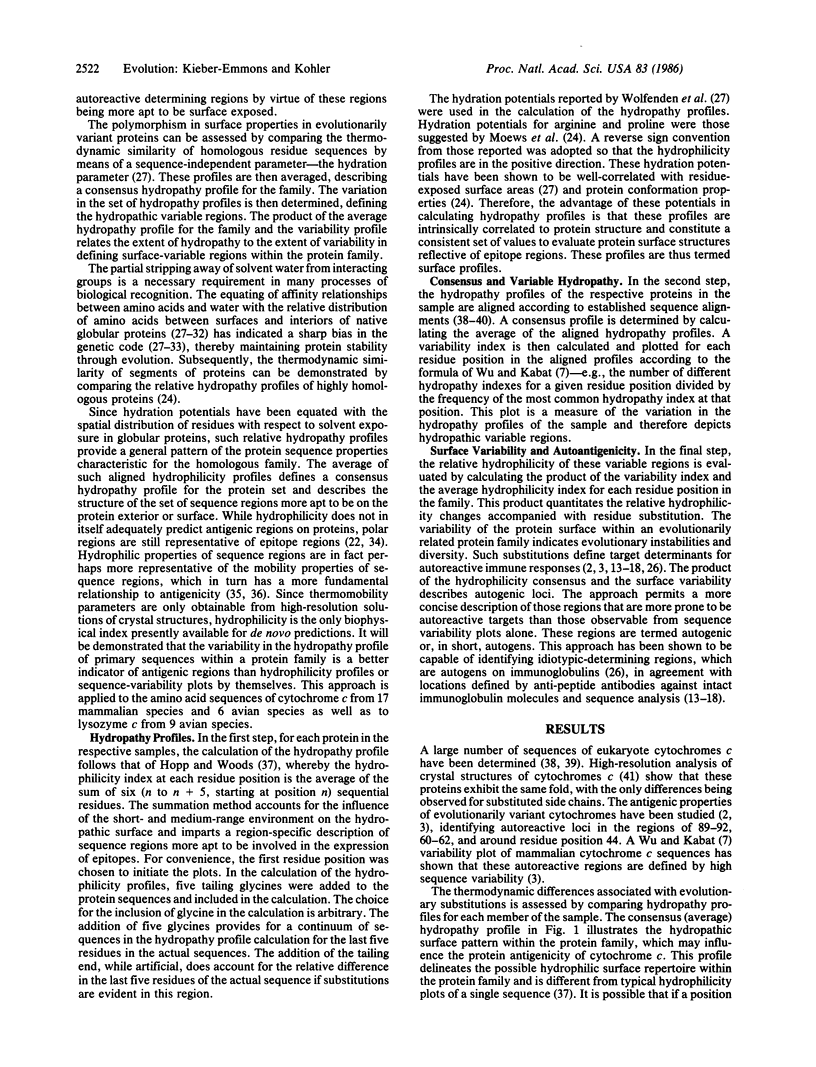
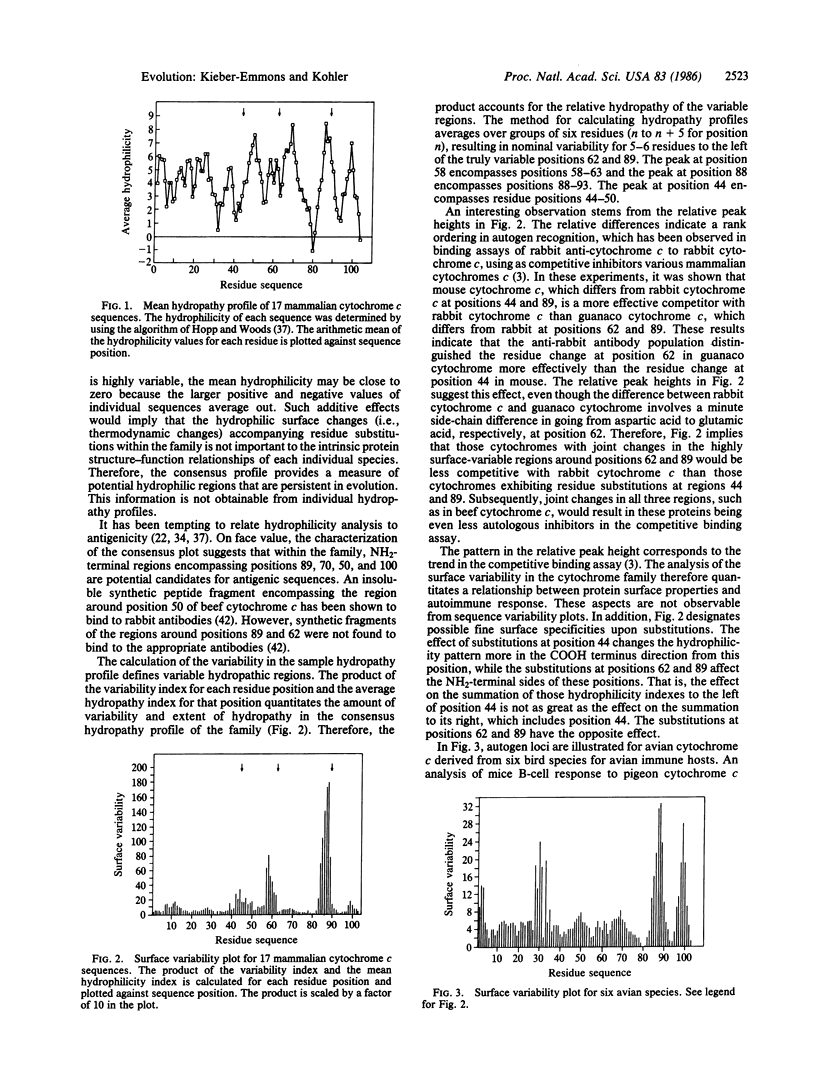
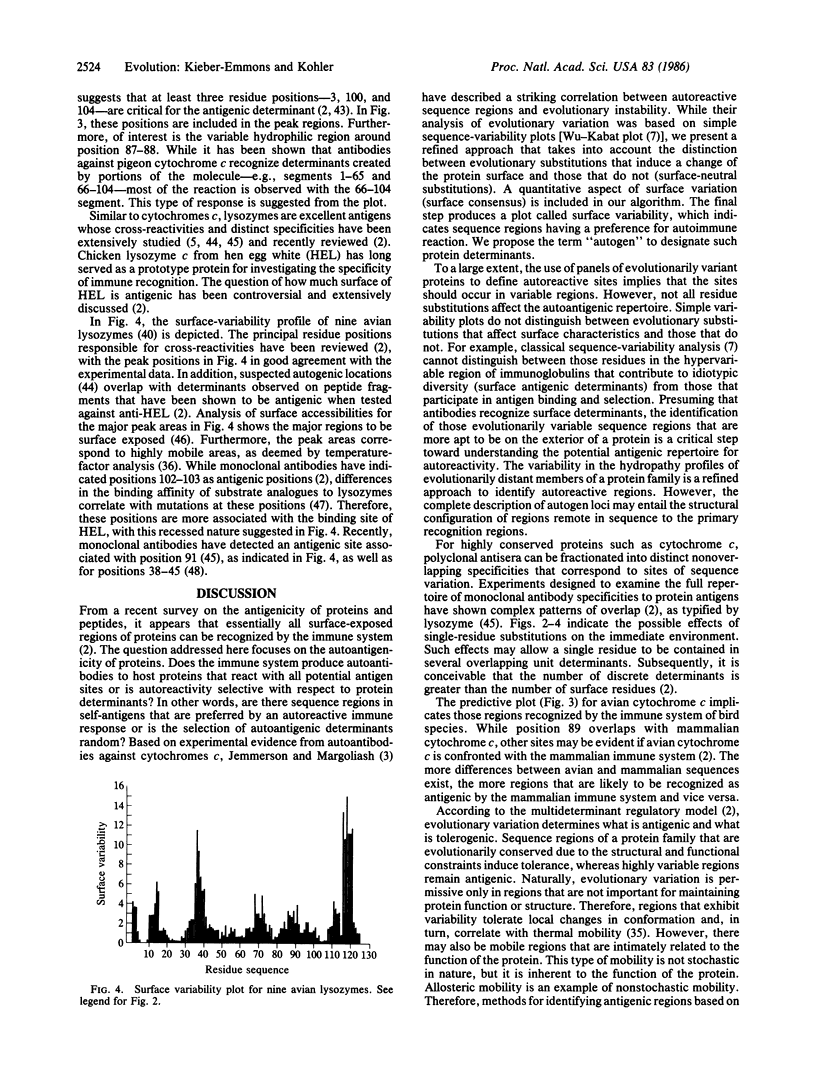
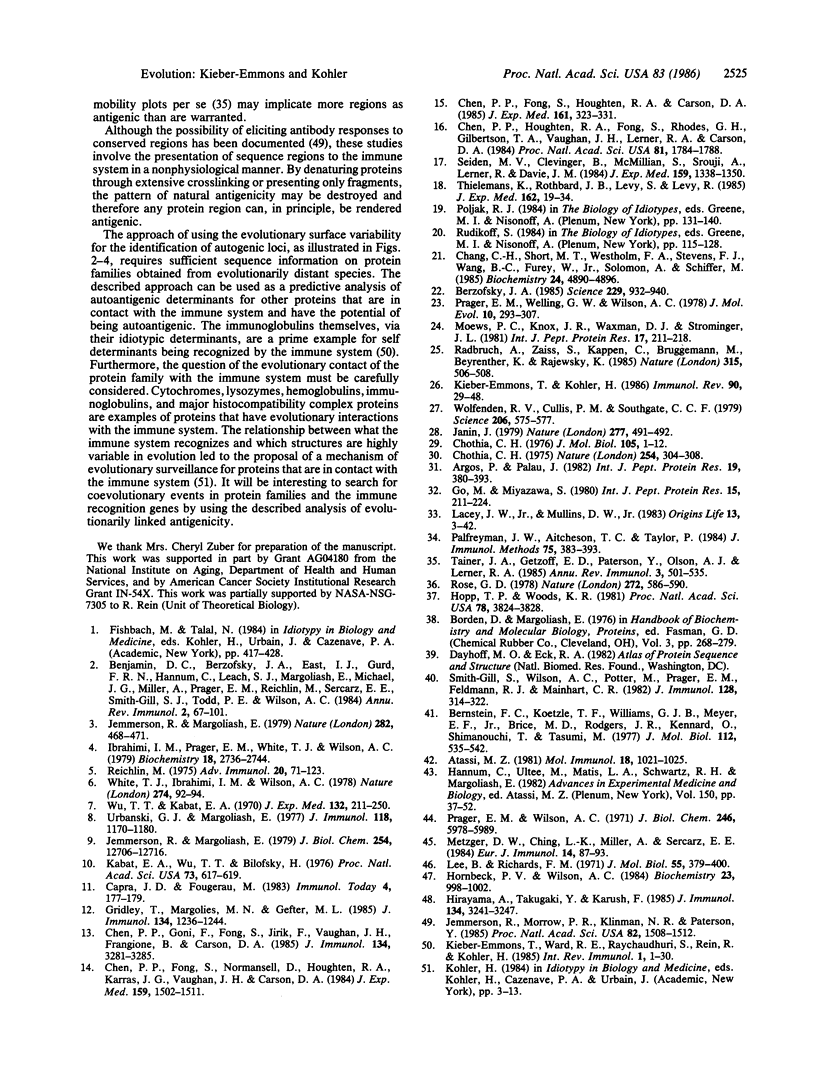
Selected References
These references are in PubMed. This may not be the complete list of references from this article.
- Argos P., Palau J. Amino acid distribution in protein secondary structures. Int J Pept Protein Res. 1982 Apr;19(4):380–393. doi: 10.1111/j.1399-3011.1982.tb02619.x. [DOI] [PubMed] [Google Scholar]
- Atassi M. Z. Immune recognition of cytochrome C. I. Investigation by synthesis whether antigenic sites of polymeric cytochrome coincide with locations of sequence differences between the immunizing and host cytochromes. Mol Immunol. 1981 Nov;18(11):1021–1025. doi: 10.1016/0161-5890(81)90121-8. [DOI] [PubMed] [Google Scholar]
- Benjamin D. C., Berzofsky J. A., East I. J., Gurd F. R., Hannum C., Leach S. J., Margoliash E., Michael J. G., Miller A., Prager E. M. The antigenic structure of proteins: a reappraisal. Annu Rev Immunol. 1984;2:67–101. doi: 10.1146/annurev.iy.02.040184.000435. [DOI] [PubMed] [Google Scholar]
- Bernstein F. C., Koetzle T. F., Williams G. J., Meyer E. F., Jr, Brice M. D., Rodgers J. R., Kennard O., Shimanouchi T., Tasumi M. The Protein Data Bank: a computer-based archival file for macromolecular structures. J Mol Biol. 1977 May 25;112(3):535–542. doi: 10.1016/s0022-2836(77)80200-3. [DOI] [PubMed] [Google Scholar]
- Berzofsky J. A. Intrinsic and extrinsic factors in protein antigenic structure. Science. 1985 Sep 6;229(4717):932–940. doi: 10.1126/science.2410982. [DOI] [PubMed] [Google Scholar]
- Chang C. H., Short M. T., Westholm F. A., Stevens F. J., Wang B. C., Furey W., Jr, Solomon A., Schiffer M. Novel arrangement of immunoglobulin variable domains: X-ray crystallographic analysis of the lambda-chain dimer Bence-Jones protein Loc. Biochemistry. 1985 Aug 27;24(18):4890–4897. doi: 10.1021/bi00339a025. [DOI] [PubMed] [Google Scholar]
- Chen P. P., Fong S., Houghten R. A., Carson D. A. Characterization of an epibody. An antiidiotype that reacts with both the idiotype of rheumatoid factors (RF) and the antigen recognized by RF. J Exp Med. 1985 Feb 1;161(2):323–331. doi: 10.1084/jem.161.2.323. [DOI] [PMC free article] [PubMed] [Google Scholar]
- Chen P. P., Fong S., Normansell D., Houghten R. A., Karras J. G., Vaughan J. H., Carson D. A. Delineation of a cross-reactive idiotype on human autoantibodies with antibody against a synthetic peptide. J Exp Med. 1984 May 1;159(5):1502–1511. doi: 10.1084/jem.159.5.1502. [DOI] [PMC free article] [PubMed] [Google Scholar]
- Chen P. P., Goñi F., Fong S., Jirik F., Vaughan J. H., Frangione B., Carson D. A. The majority of human monoclonal IgM rheumatoid factors express a "primary structure-dependent" cross-reactive idiotype. J Immunol. 1985 May;134(5):3281–3285. [PubMed] [Google Scholar]
- Chen P. P., Houghten R. A., Fong S., Rhodes G. H., Gilbertson T. A., Vaughan J. H., Lerner R. A., Carson D. A. Anti-hypervariable region antibody induced by a defined peptide: an approach for studying the structural correlates of idiotypes. Proc Natl Acad Sci U S A. 1984 Mar;81(6):1784–1788. doi: 10.1073/pnas.81.6.1784. [DOI] [PMC free article] [PubMed] [Google Scholar]
- Chothia C. Structural invariants in protein folding. Nature. 1975 Mar 27;254(5498):304–308. doi: 10.1038/254304a0. [DOI] [PubMed] [Google Scholar]
- Chothia C. The nature of the accessible and buried surfaces in proteins. J Mol Biol. 1976 Jul 25;105(1):1–12. doi: 10.1016/0022-2836(76)90191-1. [DOI] [PubMed] [Google Scholar]
- Go M., Miyazawa S. Relationship between mutability, polarity and exteriority of amino acid residues in protein evolution. Int J Pept Protein Res. 1980 Mar;15(3):211–224. doi: 10.1111/j.1399-3011.1980.tb02570.x. [DOI] [PubMed] [Google Scholar]
- Gridley T., Margolies M. N., Gefter M. L. The association of various D elements with a single-immunoglobulin VH gene segment: influence on the expression of a major cross-reactive idiotype. J Immunol. 1985 Feb;134(2):1236–1244. [PubMed] [Google Scholar]
- Hirayama A., Takagaki Y., Karush F. Interaction of monoclonal anti-peptide antibodies with lysozyme. J Immunol. 1985 May;134(5):3241–3247. [PubMed] [Google Scholar]
- Hopp T. P., Woods K. R. Prediction of protein antigenic determinants from amino acid sequences. Proc Natl Acad Sci U S A. 1981 Jun;78(6):3824–3828. doi: 10.1073/pnas.78.6.3824. [DOI] [PMC free article] [PubMed] [Google Scholar]
- Hornbeck P. V., Wilson A. C. Local effects of amino acid substitutions on the active site region of lysozyme: a comparison of physical and immunological results. Biochemistry. 1984 Feb 28;23(5):998–1002. doi: 10.1021/bi00300a031. [DOI] [PubMed] [Google Scholar]
- Ibrahimi I. M., Prager E. M., White T. J., Wilson A. C. Amino acid sequence of California quail lysozyme. Effect of evolutionary substitutions on the antigenic structure of lysozyme. Biochemistry. 1979 Jun 26;18(13):2736–2744. doi: 10.1021/bi00580a008. [DOI] [PubMed] [Google Scholar]
- Janin J. Surface and inside volumes in globular proteins. Nature. 1979 Feb 8;277(5696):491–492. doi: 10.1038/277491a0. [DOI] [PubMed] [Google Scholar]
- Jemmerson R., Margoliash E. Specificity of the antibody response of rabbits to a self-antigen. Nature. 1979 Nov 29;282(5738):468–471. doi: 10.1038/282468a0. [DOI] [PubMed] [Google Scholar]
- Jemmerson R., Margoliash E. Topographic antigenic determinants on cytochrome c. Immunoadsorbent separation of the rabbit antibody populations directed against horse cytochrome. J Biol Chem. 1979 Dec 25;254(24):12706–12716. [PubMed] [Google Scholar]
- Jemmerson R., Morrow P. R., Klinman N. R., Paterson Y. Analysis of an evolutionarily conserved antigenic site on mammalian cytochrome c using synthetic peptides. Proc Natl Acad Sci U S A. 1985 Mar;82(5):1508–1512. doi: 10.1073/pnas.82.5.1508. [DOI] [PMC free article] [PubMed] [Google Scholar]
- Kabat E. A., Wu T. T., Bilofsky H. Attempts to locate residues in complementarity-determining regions of antibody combining sites that make contact with antigen. Proc Natl Acad Sci U S A. 1976 Feb;73(2):617–619. doi: 10.1073/pnas.73.2.617. [DOI] [PMC free article] [PubMed] [Google Scholar]
- Kieber-Emmons T., Kohler H. Towards a unified theory of immunoglobulin structure-function relations. Immunol Rev. 1986 Apr;90:29–48. doi: 10.1111/j.1600-065x.1986.tb01476.x. [DOI] [PubMed] [Google Scholar]
- Kieber-Emmons T., Ward R. E., Raychaudhuri S., Rein R., Kohler H. Rational design and application of idiotope vaccines. Int Rev Immunol. 1986 Jan;1(1):1–26. doi: 10.3109/08830188609056598. [DOI] [PubMed] [Google Scholar]
- Lacey J. C., Jr, Mullins D. W., Jr Experimental studies related to the origin of the genetic code and the process of protein synthesis--a review. Orig Life. 1983 Mar;13(1):3–42. doi: 10.1007/BF00928761. [DOI] [PubMed] [Google Scholar]
- Lee B., Richards F. M. The interpretation of protein structures: estimation of static accessibility. J Mol Biol. 1971 Feb 14;55(3):379–400. doi: 10.1016/0022-2836(71)90324-x. [DOI] [PubMed] [Google Scholar]
- Metzger D. W., Ch'ng L. K., Miller A., Sercarz E. E. The expressed lysozyme-specific B cell repertoire. I. Heterogeneity in the monoclonal anti-hen egg white lysozyme specificity repertoire, and its difference from the in situ repertoire. Eur J Immunol. 1984 Jan;14(1):87–93. doi: 10.1002/eji.1830140116. [DOI] [PubMed] [Google Scholar]
- Moews P. C., Knox J. R., Waxman D. J., Strominger J. L. Secondary structure relations between beta-lactamases and penicillin-sensitive D-alanine-carboxypeptidases. Int J Pept Protein Res. 1981 Feb;17(2):211–218. doi: 10.1111/j.1399-3011.1981.tb01984.x. [DOI] [PubMed] [Google Scholar]
- Palfreyman J. W., Aitcheson T. C., Taylor P. Guidelines for the production of polypeptide specific antisera using small synthetic oligopeptides as immunogens. J Immunol Methods. 1984 Dec 31;75(2):383–393. doi: 10.1016/0022-1759(84)90122-4. [DOI] [PubMed] [Google Scholar]
- Prager E. M., Welling G. W., Wilson A. C. Comparison of various immunological methods for distinguishing among mammalian pancreatic ribonucleases of known amino acid sequence. J Mol Evol. 1978 Feb 21;10(4):293–307. doi: 10.1007/BF01734219. [DOI] [PubMed] [Google Scholar]
- Prager E. M., Wilson A. C. The dependence of immunological cross-reactivity upon sequence resemblance among lysozymes. I. Micro-complement fixation studies. J Biol Chem. 1971 Oct 10;246(19):5978–5989. [PubMed] [Google Scholar]
- Radbruch A., Zaiss S., Kappen C., Brüggemann M., Beyreuther K., Rajewsky K. Drastic change in idiotypic but not antigen-binding specificity of an antibody by a single amino-acid substitution. Nature. 1985 Jun 6;315(6019):506–508. doi: 10.1038/315506a0. [DOI] [PubMed] [Google Scholar]
- Reichlin M. Amino acid substitution and the antigenicity of globular proteins. Adv Immunol. 1975;20:71–123. doi: 10.1016/s0065-2776(08)60207-2. [DOI] [PubMed] [Google Scholar]
- Rose G. D. Prediction of chain turns in globular proteins on a hydrophobic basis. Nature. 1978 Apr 13;272(5654):586–590. doi: 10.1038/272586a0. [DOI] [PubMed] [Google Scholar]
- Seiden M. V., Clevinger B., McMillan S., Srouji A., Lerner R., Davie J. M. Chemical synthesis of idiotopes. Evidence that antisera to the same JH1 peptide detect multiple binding site-associated idiotopes. J Exp Med. 1984 May 1;159(5):1338–1350. doi: 10.1084/jem.159.5.1338. [DOI] [PMC free article] [PubMed] [Google Scholar]
- Smith-Gill S. J., Wilson A. C., Potter M., Prager E. M., Feldmann R. J., Mainhart C. R. Mapping the antigenic epitope for a monoclonal antibody against lysozyme. J Immunol. 1982 Jan;128(1):314–322. [PubMed] [Google Scholar]
- Tainer J. A., Getzoff E. D., Paterson Y., Olson A. J., Lerner R. A. The atomic mobility component of protein antigenicity. Annu Rev Immunol. 1985;3:501–535. doi: 10.1146/annurev.iy.03.040185.002441. [DOI] [PubMed] [Google Scholar]
- Thielemans K., Rothbard J. B., Levy S., Levy R. Syngeneic antiidiotypic immune responses to a B cell lymphoma. Comparison between heavy chain hypervariable region peptides and intact Ig as immunogens. J Exp Med. 1985 Jul 1;162(1):19–34. doi: 10.1084/jem.162.1.19. [DOI] [PMC free article] [PubMed] [Google Scholar]
- Urbanski G. J., Margoliash E. Topographic determinants on cytochrome c. I. The complete antigenic structures of rabbit, mouse, and guanaco cytochromes c in rabbits and mice1. J Immunol. 1977 Apr;118(4):1170–1180. [PubMed] [Google Scholar]
- White T. J., Ibrahimi I. M., Wilson A. C. Evolutionary substitutions and the antigenic structure of globular proteins. Nature. 1978 Jul 6;274(5666):92–94. doi: 10.1038/274092a0. [DOI] [PubMed] [Google Scholar]
- Wolfenden R. V., Cullis P. M., Southgate C. C. Water, protein folding, and the genetic code. Science. 1979 Nov 2;206(4418):575–577. doi: 10.1126/science.493962. [DOI] [PubMed] [Google Scholar]
- Wu T. T., Kabat E. A. An analysis of the sequences of the variable regions of Bence Jones proteins and myeloma light chains and their implications for antibody complementarity. J Exp Med. 1970 Aug 1;132(2):211–250. doi: 10.1084/jem.132.2.211. [DOI] [PMC free article] [PubMed] [Google Scholar]


